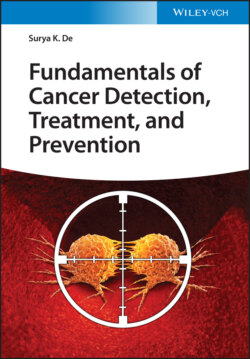Читать книгу Fundamentals of Cancer Detection, Treatment, and Prevention - Surya K. De - Страница 75
2.13 Known Human Carcinogens 2.13.1 Arsenic, Coal Tar, Coal‐tar Pitch, Diesel, Asbestos, Formaldehyde, and Air Pollutants
ОглавлениеArsenic is a widely distributed, natural element found in the Earth's crust. In its inorganic form, it is toxic to the human body and a known carcinogen [82]. It reaches people through contaminated drinking water in less‐developed countries such as Bangladesh, and it can find its way into food produced from crops irrigated with arsenic‐contaminated water (Figure 2.12).
Figure 2.12 Arsenic causes cancer.
Source: darkoudovicic/Adobe Stock
.
The WHO estimates that at least 140 million people in 50 countries drink water containing high levels of arsenic. In addition, arsenic is one of the cancer‐causing agents in tobacco.
Coal tar and coal‐tar pitch are coal derivatives widely used for various commercial and industrial purposes. Research findings suggest that miners who are exposed to the process of coal gasification and other occupational workers involved (Figure 2.13) with coal tar or coal‐tar pitch suffer significantly higher rates of skin cancer and cancers of the lungs, bladder, kidney, and digestive tract [83,84].
Figure 2.13 Coal exposure can cause cancer.
Source: Anzelm/Adobe Stock
.
Diesel exhaust from the burning of diesel oil has over 30 components (Figure 2.14) that can cause various types of cancer, according to the International Agency for Research on Cancer [85–95].
Figure 2.14 Exposure of diesel exhaust can cause cancer.
Source: Alexandr Mitiuc/Adobe Stock
.
Fracking is the process of drilling down into the lower layers of the earth and injecting liquid at high pressure, in order to force open existing fissures and extract oil or gas (Figure 2.15). During this technique, however, cancer‐causing compounds including benzene and formaldehyde may be released into the air and groundwater [96].
Figure 2.15 Exposure to fracking can cause cancer.
Asbestos is a naturally occurring mineral substance that has a fibrous structure. For this reason, it can be pulled into a fluffy consistency. Asbestos was used as an insulation material (Figure 2.16) for years before the dust was linked to lung cancer [98]. It is also linked to mesothelioma, another serious and potentially fatal disease (see later chapter on Mesothelioma).
Figure 2.16 Exposure to asbestos causes lung cancer.
Source: Profotokris/Adobe Stock
.
Products that contain asbestos are not completely banned in the United States, though the Environmental Protection Agency (EPA) regulates their use.
Formaldehyde is a chemical compound used as a constituent of certain building materials and some types of glue, as well as a preserving agent and disinfectant (Figure 2.17). Scientists have known for years that formaldehyde can cause nasal cancer in rats, and the International Agency for Research on Cancer reports that it is a carcinogen for humans also [99–104].
Figure 2.17 Formaldehyde can cause cancer.
Source: betka82/Adobe Stock
.
Air pollution is defined as the presence of poisonous chemicals or compounds (organic or inorganic) in the air we breathe, at levels that pose a health risk. Air contaminated with pollution, which can exist as particulates, biological molecules, or gases, can lead to various types of cancer [105,106]. One example is soot, which is contaminated carbon particles resulting from incomplete burning of organic material. Even as long ago as the 1770s, chimney sweeps in London were developing scrotal cancer at higher rates than in the general population. Inhalation of soot has also been linked to lung, esophageal, and bladder cancers.
